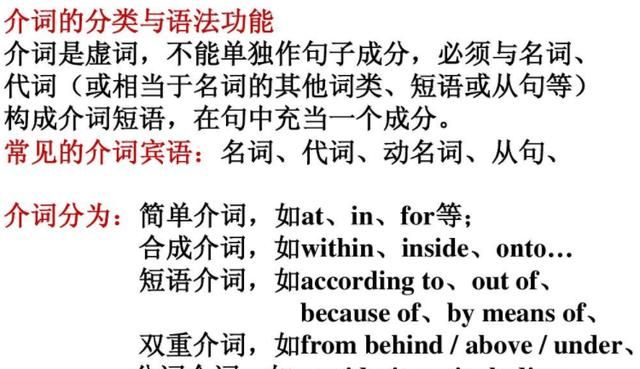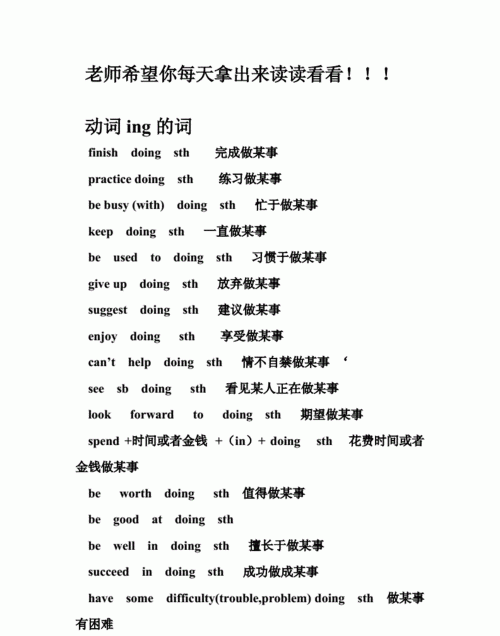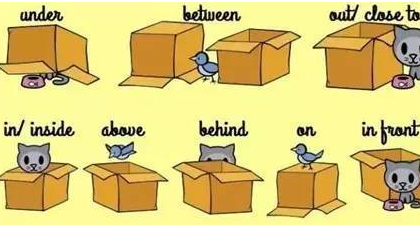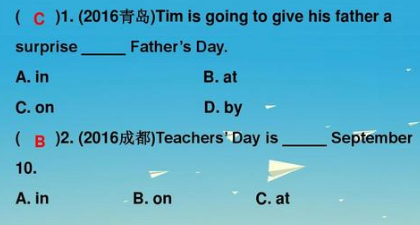本文目录
英语中介词后面的动词要加ing吗
所有介词后面的
动词
是ing形式,根本原因是因为,介词后面都是
要加名词的,动词的ing形式也就形成了动名词。

哪些介词后面用动词ing形式
be addicted to 沉溺于;对…上瘾
be opposed to 反对
devote oneself to献身于;专心于
be devoted to 致力于;忠诚于
be admitted to 被…录取;准进入
be reduced to 沦为
reduce…to…使…沦为
be attached to附属于;喜欢;依恋
be adjusted to 适应
be known to 为…所知
be married to 和…结婚
be sentenced to被判处
be connected to 和…连在一起
be exposed to 暴露于;遭受
be compared to 被比喻成
compare… to…把…比作…
be engaged to 与…订婚
be / become / get accustomed to // accustomed to 惯于;有…习惯
be engaged to 与…订婚
get/settle down to 着手做
lead to 导致
object to反对;不喜欢;不赞成
put one’s mind to全神贯注于
give rise to 引起
look forward to 盼望
stick to 坚持
pay attention to 注意
attend to 专心;注意;照料
see to 负责;注意
contribute to对…作贡献;有助于
make contributions to对…作贡献
apply oneself to 致力于
come close to几乎;将近
reply to 回答
add to 增加
add up to 加起来
in addition to除…之外
turn to转向;求助于
look up to 尊敬
admit to承认
belong to 属于
take to 喜爱;开始
cling to 附着
fall to 开始
respond to 回答;对…作出回应
accustom oneself to 使自己习惯于
amount to等于
prefer… to…更喜欢
set an example to 给…树立榜样
refer to 谈到;参考;查阅
agree to sth. 同意某事 (比较:agree to do sth. 同意做某事)
prefer… to…更喜欢
take / make at rip to到…地方去
join…to…把…和 …连接起来
turn a blind eye to对…视而不见
turn a deaf ear to 对…充耳不闻
show honor to向…表示敬意
put an end to(bring… to an end) 结束
set fire to 放火烧……
drink (a toast) to 为……干杯
propose a toast to 提议……
happen to… 发生了……事
occur to sb. 想起;想到
total up to 总计达
be close to 几乎;将近
hold to 坚持;抓住
help oneself to 随便用……
hold on to 抓住;固守
do harm to 对……有害处
do wrong to 冤枉某人
date back to 追溯到
when it comes to… 谈到……时
come to 来到;达到;结果为 (比较:come to do sth逐渐做某事)
give an eye to着眼于
have an eye to doing 打算
the key to ……的答案
describe to 向……描述
treat sb. to sth. 请某人吃……
trust sth. to sb.把某物委托给某人
pay a visit to 参观……
access to 进入;取得的方法
be a stranger to 不习惯;对……陌生
on one’s way to 在去某处的路上;在达成某事的过程中
be kind to 对……和善
be important to 对……重要
be senior to 年龄长于……
be equal to 和……相等
be particular to ……所特有的(比较:be particular about 对……过于讲究;挑剔)
be subject to 服从;隶属;易遭\受\患
be familiar to 为 ……熟悉
be similar to 和……相似
be open to 对……开放
be loyal to 对……忠诚
be helpful to对……有益处
be useful to对……有用
be good to sb对某人好 (比较:be good for 对……有益处)
be bad to 对……不好
be bad for(比较:对……有害处)
be new to 对……不习惯;对……陌生
as to 关于;至于
next to(否定词前)几乎;
be due to do sth.预定要做某事
next to ……的旁边
due to 由于;归因于……
thanks to 多亏了;由于
owing to 由于;因……的缘故
in / with regard to 关于
in /with relation to 关于;就……而论
subject to 在……条件下;依照
be given to 沉溺于
be related to 与…相关
get down to着手做
lead to 着手做
object to / be opposed to 反对
put one’s mind to全神贯注于
be equal to 胜任
devote oneself to献身于
give rise to 引起
look forward to 盼望
pay attention to 注意
lead to通向 see to 负责
access to 接近(某地的)方法
be addicted to 沉溺于… 对…上瘾
according to 根据
contribute to 为…作贡献
。。。。。。。。。。。。。。。。。。。。。。。。。。。。。。。。。。
为了学好英语,我建议你平时多听老师讲吧,还有平时多注意积累,一点一点最后就有好多了。。。加油吧

哪些介词后面用动词ing形式
介词后面跟动词,都加ing,to后加动词原型,是因为它是不定式。当它单纯作介词时,加ing。
介词加动词的时候,要把动词名词化,变成动名词,就是加ing。to作为介词的时候,作为不定式后面的确是加动词原形,但是作为介词的时候后面是接ing的,例如:object to doing 这个就是很典型的例子,表示反对的意思,这里的to就是作为介词使用。

扩展资料
各类介词用法口诀:
1、早、午、晚要用in,at黎明、午夜、点与分。
2、年、月、年月、季节、周,阳光、灯、影、衣、冒in。
3、将来时态in...以后,小处at大处in。
4、有形with无形by,语言、单位、材料in。
5、特征、方面与方式,心情成语惯用in。
6、介词at和to表方向,攻击、位置、恶、善分。
英语中介词后面的动词要加ing吗
介词后面跟动词,都加ing,to后加动词原型,是因为它是不定式。当它单纯作介词时,肯定加ing。
to也有作为介词的时候,作为不定式后面的确是加动词原形,但是作为介词的时候后面是接ing的,例如:object to doing 这个就是很典型的例子,表示反对的意思,这里的to就是作为介词使用。

扩展资料
介词at, in, on的区别:
表示时间,注意以下用法:
1、 表示时间的某一点、某一时刻或年龄等用 at。如:
I get up at six in the morning. 我早上六点钟起床。
2、 泛指一般意义的上午、下午或晚上以及月或年等较长的时间,一般用 in。如:
We watch TV in the evening. 我们晚上看电视。
3)、若表示星期几或某一特定的日期,则用 on。如:
He left here on the fifth of May. 他于 5 月 5 日离开这儿。
以上就是关于30个常用介词后加ing形式 ,英语中介词后面的动词要加ing吗的全部内容,以及30个常用介词后加ing形式 的相关内容,希望能够帮到您。

